Expansion of Paddy Farming in the Northeast Region of China and Its Impact on the Local Environment: Case Studies of Baicheng and Da'an Cities, Jilin Province
Main Article Content
Abstract
China is the most populous country in the world, and ensuring food security for a huge and growing population is the largest issue for the Chinese government. In northern China, especially in arid and semi-arid regions, poor natural environment, signified by a high degree of soil salinization, a large number of saline and alkaline land not only hinders the increase of food production but also promotion of farmers' income. This has impeded regional sustainable development. In order to ameliorate the saline-alkali land, improve the ecological environment, increase rice output and promote farmers' income, China has carried out projects of saline-alkali land amelioration by planting paddy in the northeast semi-arid region since the 1980s. Results show that rice cultivation is a very effective way to ameliorating the saline-alkali land, and it can increase the rice while promoting income of farmers. This paper analyzes the cost and benefits of growing rice and examines the impact of paddy farming on the local environment.
Downloads
Article Details
Copyright
Submission of a manuscript to the WILAYAH implies that the submitted work has not been published before (except as part of a thesis or report or abstract), that it is not under consideration for publication elsewhere; that all co-authors have approved its publication. The WILAYAH : International Journal of East Asian Studies adopts CC BY license. As such, we would be grateful if an acknowledgement accompanies the republication that the work was originally published in WILAYAH. The editors will ensure digital preservation of access to the journal content by the Journal depository section.
Disclaimer
Although the Department of East Asian Studies is the publisher of the WILAYAH : International Journal of East Asian Studies, the views presented in the WILAYAH are entirely those of the contributors and do not reflect the official stand of the Department of East Asian Studies. The Department does not hold itself responsible for the accuracy of any article published. Publisher and co-publishers assume no responsibility, nor by the editors for any injury and/or damage to persons or property as a result of any actual or alleged libellous statements, infringement of intellectual property or privacy rights, or products liability, whether resulting from negligence or otherwise, or from any use or operation of any ideas, instructions, procedures, products or methods contained in the material therein.

